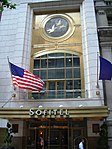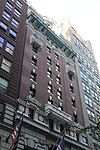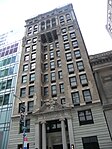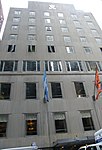Harvard Club of New York
Clubhouses on the National Register of Historic Places in ManhattanClubs and societies in New York CityCulture of ManhattanGentlemen's clubs in New York CityHarvard University ... and 5 more
McKim, Mead & White buildingsMidtown ManhattanNew York City Designated Landmarks in ManhattanOrganizations established in 1887Use mdy dates from October 2021

The Harvard Club of New York City, commonly called The Harvard Club, is a private social club located in Midtown Manhattan, New York City. Its membership is limited to alumni, faculty, and boardmembers of Harvard University. Incorporated in 1887, it is housed in adjoining lots at 27 West 44th Street and 35 West 44th Street. The original wing, built in 1894, was designed in red brick neo-Georgian style by Charles Follen McKim of McKim, Mead & White.
Excerpt from the Wikipedia article Harvard Club of New York (License: CC BY-SA 3.0, Authors, Images).Harvard Club of New York
West 45th Street, New York Manhattan
Geographical coordinates (GPS) Address Nearby Places Show on map
Geographical coordinates (GPS)
| Latitude | Longitude |
|---|---|
| N 40.75566 ° | E -73.9812 ° |
Address
West 45th Street 40
10036 New York, Manhattan
New York, United States
Open on Google Maps










